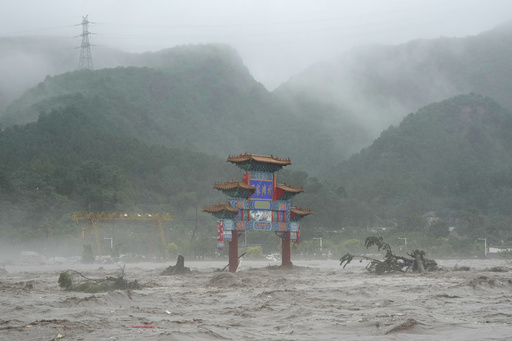China is grappling with an unprecedented natural disaster as Tropical Storm Doksuri unleashes the heaviest rains in 140 years. The capital region, including Beijing, is reeling from torrential downpours, leaving at least 20 people dead and 27 others missing. Emergency personnel have been dispatched to the worst-affected areas as authorities scramble to rescue survivors and minimize further loss of life and property damage. President Xi Jinping has called for an all-out effort to confront the disaster head-on. Let’s delve into the grim situation that has unfolded over the past few days.
Unprecedented Deluge in Beijing and Surrounding Areas
Since Saturday, Tropical Storm Doksuri has wreaked havoc across China, with the capital region bearing the brunt of its fury. This natural calamity has unleashed a staggering 744.8mm (29.3 inches) of rainfall at a reservoir on the outskirts of Beijing, marking the highest recorded rainfall since 1891. Shockingly, the amount of rainfall in just 40 hours came close to the average for the entire month of July. The region’s infrastructure and emergency services have been stretched to the limit as they struggle to cope with the relentless onslaught of water.
Zhuozhou Hit Hard, Thousands Evacuated
Among the hardest-hit areas is the city of Zhuozhou, situated approximately 60km (37 miles) southwest of Beijing. The confluence of several rivers made the city particularly vulnerable, as floodwaters surged downstream from other inundated regions. As a result, Zhuozhou faced severe devastation, with rescue efforts focused on this area to ensure the safety of its residents. Authorities deployed thousands of emergency personnel to assist in evacuation and relief operations.
President Xi Jinping’s Call for Swift Action
In the face of this natural catastrophe, Chinese President Xi Jinping has issued a clear directive to all local governments: spare no effort in rescuing survivors and limiting the loss of life and property damage. The President’s call to action emphasizes the gravity of the situation and mobilizes authorities at all levels to coordinate rescue and relief operations promptly. The government’s priority is to ensure the safety of its citizens and alleviate their suffering during these challenging times.
Amidst the chaos, the public’s safety remains paramount. Consequently, nearly one million people have been evacuated from Beijing and the neighboring Hebei province. This large-scale evacuation effort aims to safeguard lives and protect communities from the relentless onslaught of rising waters. However, the situation remains fluid, and authorities continue to closely monitor the weather patterns.
A Grim Reminder of Past Tragedies
This disaster brings to mind the heart-wrenching floods that devastated China in 1998 along the Yangtze River and other waterways, claiming over 4,000 lives and displacing millions. As the nation grapples with this current calamity, the memories of past tragedies serve as a grim reminder of the importance of preparedness and quick response during such natural disasters.
With the storm’s movement now heading northward, and some respite from the flooding in Beijing, authorities are cautiously optimistic. As they continue to assess the damage and assist those affected, the government remains steadfast in its commitment to safeguarding lives and ensuring a swift recovery from this extraordinary event. Nevertheless, the impact of these record rains will leave a lasting imprint on the hearts of the Chinese people and serve as a stark reminder of the need for ongoing vigilance in the face of changing weather patterns.















